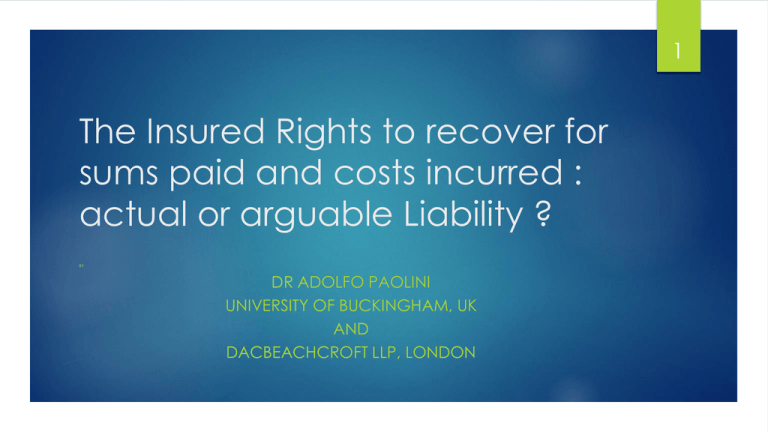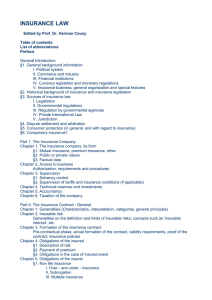Presentation
advertisement

1 The Insured Rights to recover for sums paid and costs incurred : actual or arguable Liability ? BY DR ADOLFO PAOLINI UNIVERSITY OF BUCKINGHAM, UK AND DACBEACHCROFT LLP, LONDON 2 The Scope of Liability Policies Liability at Law: is there a loss? Potential Liability to pay damages could amount to a detriment / insurable Interest Old approach: nothing but payment as proof of loss/pay to be paid New approach: right accrues as soon as insured’s liability is ascertained by judgement, award or binding settlement. Post Office v Norwich Union [1967] Consequently: the right to be indemnified accrues when such liability is established and not when the event happened in the past or when payment is made in the future. 3 Omega Proteins v Aspen Insurance 1. The insured must establish that it has suffered a loss which is covered 2. How: by showing a judgement, award or agreement to pay 3. The loss must be within the scope of the cover 4. The judgement, award or agreement, must settled the question as to whether the loss is covered by the policy 5. Neither the judgement nor the agreement are determinative of whether or not the loss is covered by the policy ( assuming that the insurer is not a party/ No agreement to be bound 6. It is open to insurers to dispute that the insured was liable/ exclusions 7. Insurers have the right to enquire as to the real nature of insured’s liability 8. Insureds do also have the right to dispute the nature of liability with insurers as to secure cover. 4 Astrazeneca v. XL and ACE: The Facts Product Liability claim/ class action Product: antipsychotic drug ‘Seroquel’ which contained information about weight gain and diabetes. USA and Canadian Manufacturer/The Group of Companies (AZ) Putative class action was filed in Florida on the ground that Seroquel caused personal injury, it was defective and failure to provide adequate warning The US manufacturer issued the claimants with a notice of integrated occurrence in accordance with the insurance policy The insurer settled claims £83.5 ( only one case was litigated) and several dismissed Also paid £ 786 million in defence costs/ average £ 20000 per claim. 5 Astrazeneca v. XL and ACE: The Policy Astrazeneca Captive Insurance for the manufacturing group Policy/ Bermuda Form Governed by English Law Insurer has no duty to defend Did not have a follow the settlements clause Occurrence reported policy Also provided the aggregation of personal injuries into one occurrence Defence Costs were included within and not in addition to the policy limits XL and ACE were the reinsurers Astrazeneca v. XL and ACE: The Dispute/ Issue One 1. Applicable Law as to the interpretation of the agreement: English v. New York State. 2. Bermuda Forms/ English Arbitrators and New York State Law. 3. AZ policy contained a choice of English Law and not arbitrators 4. Reinsurers denied cover on the grounds that according to English Law, liability must be actual and not merely arguable 5. The claimant argued that the contract contained several indications that what the parties really wanted was to applied New York Law which accepted ‘arguable liability’ as the basis for indemnity 6 Astrazeneca v. XL and ACE: The Dispute/ Issue One Claim failed/ English Law requires actual liability Express choice of English Law forces the construction of the policy according to English Law “ to indemnify the insured for ultimate net loss the insured pays by reason of liability imposed by law for damages on account of personal injury” (emphasis added) The policy required actual liability to trigger the insurer’s duty to indemnify 7 Astrazeneca v. XL and ACE: The Dispute/ Issue Two 1. Whether the defence cost cover was within and not a free-standing right 2. “ Defense Costs means reasonable legal costs and other expenses incurred by or on behalf of the insured in connection with the defense of any actual or anticipated claim” ( emphasis added) 3. Procedural and Substantive Trigger of Liability 4. “Damages means all forms of compensatory damages…. and shall include Defense Costs” 8 Astrazeneca v. XL and ACE: The Dispute/ Issue Two Claim failed/ Defence Costs was not a free-standing agreement yet part of the aggregate limit of indemnity When “Defence Costs is included as part of the losses, it complements the core insuring clause. It does not have independent existence and follows the fortunes of that clause” AP, DN Silberman v. CGU Insurance Ltd: a dishonesty exclusion relieved the insurer of liability not only for the substantive cover but also DC Wilkie v. Gordian RunOff Ltd: DC formed part of a single undertaking so an exclusion clause affects both substantive and DC cover 9 Astrazeneca v. XL and ACE: The Dispute/ Issue Two Wyeth v. Cigna: “ DC only arises when the claim falls within the terms of the primary insuring clause” When Insurers’ consent is needed, DC cover is triggered when such consent is obtained, and the claim falls within cover. Thornton Springer v. NEM Poole Harbour Yacht Club Marina Ltd v. Excess Insurance Co: “ claimant was entitled to DC incurred with insurers’ consent, in the absence of express exclusions in regard to such DC” In general, parties are free to decide but all depends on policy construction. 10 11 Conclusions Actual Liability at Law One word matters: England or New York State Law! Defence Costs follows the fortunes of the substantive cover DC could be a free standing agreement There may be insurmountable obstacles to have the right to recover in class actions cases Careful drafting, translations and negotiations are paramount 12 Thank You Dr Adolfo Paolini adolfo.paolini@buckingham.ac.uk apaolini@dacbeachcroft.com






